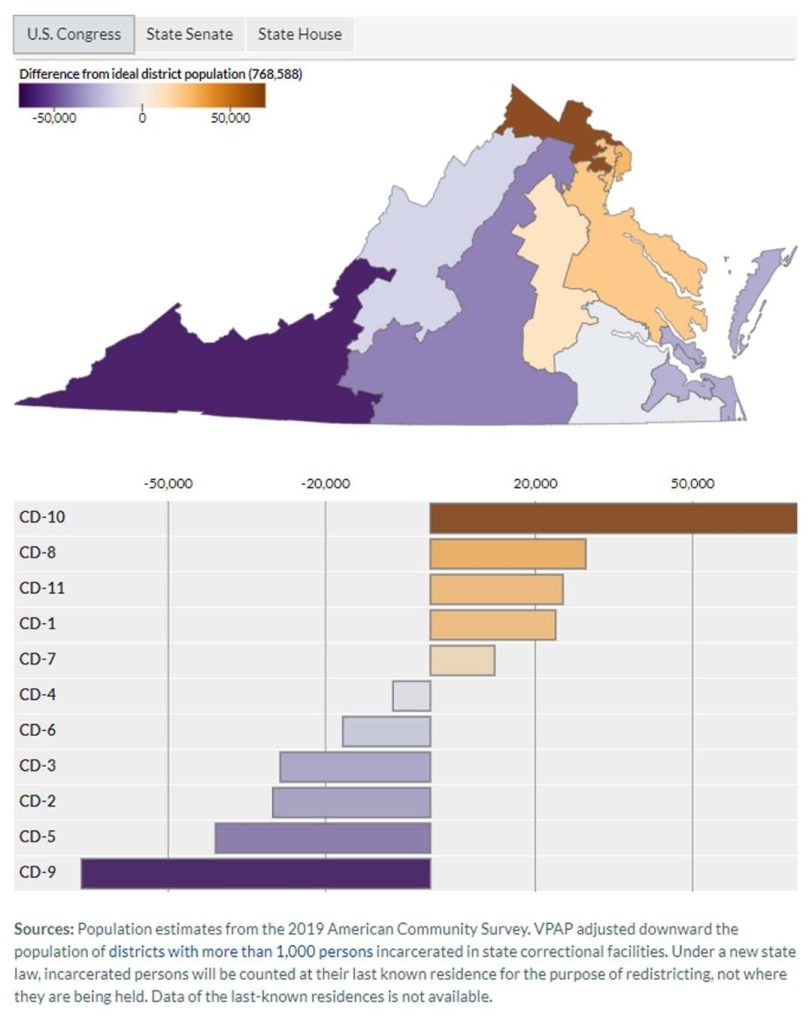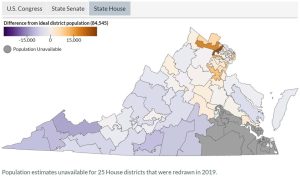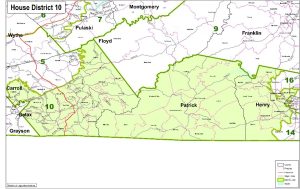
By Brandon Martin
While the newly formed Virginia Redistricting Commission is awaiting the release of the 2020 Census data to redraw congressional and state boundaries, many residents are concerned about the ability of the board to draw the lines fairly.
During a March 30 meeting, the commission heard from approximately 18 citizens across the state with most speakers asking for one thing: equality.
Ankit Jain, a volunteer with OneVirginia2021, asked the civilian members of the commission to serve as a check against the legislators who serve alongside them.
“I don’t think you should assume good faith from the politician members because we do have members on this commission, who are politicians and have participated in gerrymandering of the General Assembly district,” Jain said. “You all represent every Virginian who just wants fair maps, who wants to be choosing their politician and not the other way around. Be willing to speak out in case they push you towards an incumbent-protection gerrymander because I do think that is a risk that we are facing.”
The commission consists of 16 total members with half of the members being legislators. The eight members are Dels. Delores McQuinn, D-Richmond; Marcus Simon, D-Falls Church; Les Adams, R-Chatham; and Margaret Ransone, R-Westmoreland. The commission also includes State Sens. Mamie Locke, D-Hampton; George Barker, D-Fairfax, Ryan McDougle, R-Hanover; and Steve Newman, R-Lynchburg.
During a December 2020 panel discussion with the Virginia Press Association, Barker indicated some electoral changes for the southern parts of Virginia based on preliminary data.
“Northern Virginia is the only area of the state that will pick up much of anything at all,” Barker said. “Historically, Northern Virginia in 1940 had 1.5 Senate seats. This year, we will be up to 12 probably.”
Barker said the Fredericksburg area has also shown some growth as well.
“Northern Virginia will basically pick up two House seats, and either three-quarters or four-fifths of a Senate seat,” Barker added. “No other area, besides a tiny area in Fredericksburg, will pick up anything. The losses are all along the Southern border of Virginia. All the way from Hampton Roads to Southwest Virginia.”
Barker said the losses in Hampton Roads, Southside and Southwest Virginia will be proportional to the gains in Northern Virginia.
If the preliminary numbers are correct, this could lead to fewer representatives in Henry and Patrick counties.
During the 2011 redistricting process, the area lost representation in the 10th district.
Ward Armstrong, serving as the Minority Leader for the Democrats at the time, had his seat redrawn into non-existence by the Republican-controlled House of Delegates.
The territory within his district was split between adjacent House districts, and a new 10th District was created far away in Loudoun, Clarke, and Frederick counties to accommodate population growth in the Northern Virginia suburbs.
Of the legislators serving on the redistricting commission, only Adams represents communities in the Southside. This gives the area a voice directly on the commission. As the delegate of the 16th district, about 45 percent of Adam’s district is made up of portions of Henry County and the entire City of Martinsville, according to data by the Virginia Public Access Project (VPAP).
Henry County is represented by two additional delegates in the 9th and 14th districts, one state senator and two congressmen in the 9th and 5th districts, for a total of six representatives in one county. The number could be seen as problematic compared to current population trends.
A 2019 American Community Survey found that all three of the delegate districts in Henry County were below the “ideal” population. The 16th district is below its ideal population by 9,973 people. The 14th district is below ideal population by 7,816 people and the 9th district is below the ideal population by 5,819 people.
Additionally, the 9th and 5th congressional districts are also the farthest away from ideal population standards, with the 9th district lacking 66,550 people to meet the ideal measure and the 5th district missing the mark by 40,995.
According to VPAP, “when congressional and state legislative boundaries are redrawn this year, areas below the ideal population will lose representation (and political power), while those above stand to gain.”
This could have adverse effects on the political power of minority communities in the area, according to advocates.
Based on figures from the 2010 Census, almost a third of the population in the 16th District is a race or ethnicity other than Caucasian. The 14th District is approximately 40 percent minority. Almost 13 percent of the 9th District is the same.
If parts of the 16th District in Henry County are redrawn to be part of the 14th District, the political power of minorities in the districts to sway elections would increase. If the lines include more of the 16th district into the 9th district, the political power of minorities in Henry County would be decreased.
Phillip Thompson, executive director of the national black non-partisan redistricting organization, said he hopes the commission will help solve gerrymandering issues which impacted minority communities.
“Our primary concern in redistricting deals with minority communities,” he said. “We know the African American community is well represented on this body. We are also concerned with other minorities such as Asian Americans and the Hispanic community. We want to make sure the districts in Virginia are aligned to represent all of the communities and all of the people in Virginia.”
Until the census data is officially released, it is unknown how the new boundaries will affect minority communities throughout the state. However, the census isn’t the only thing that could affect local election districts.
During his most recent re-election bid, Martinsville City Council Member Chad Martin said he will be ensuring a city reversion does not affect the political power of minority communities in Martinsville.
“That’s not the case at all because Martinsville would still have the same jurisdiction lines,” Martin said at the time. “If the county decided to try to cut it up, then that would go to the General Assembly and they would make sure it wouldn’t happen. Those fears need to be dispelled.”
While reversion won’t impact the jurisdictional lines, the addition of the African American population of Martinsville would impact the demographic makeup of Henry County. Based on 2019 population estimates by the Census Bureau, African Americans make up 47.5 percent of Martinsville and 22.6 percent of Henry County. By combining the localities, the African American population of Henry County would increase to 28 percent after reversion.
Martinsville proposes reverting with the condition that “the Henry County Board of Supervisors should redraw Henry County’s election districts to encompass the territory within Martinsville, and a special election should be held to elect supervisors from the new districts. To provide representation for the residents of the Town of Martinsville, the area of the town should be divided among the smallest number of election districts that can be drawn in accordance with applicable requirements of state and federal law.”
Without mentioning a specific number, the county supports reversion as long as “the Henry County Board of Supervisors shall determine, in its sole discretion, how to reapportion election districts to provide representation to Martinsville’s residents, limited only by applicable federal and state constitutional and statutory law.”
Which “applicable” laws will take precedence have yet to be determined. Among normal considerations are ensuring equal populations between the districts; ensuring minority representation; ensuring the contiguity of the districts; ensuring political boundaries are kept; and ensuring the districts remain compact.






